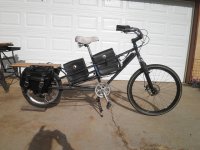Nice discussion, but lets back up a little bit. I'm guessing you want to be street legal in the USA. First of all, in the US, unless the cops know you and are after you, you may not need to be strictly " street legal" at all.
What state are you in? It matters a lot. In New Mexico for example, there is no street legal motorized bike law at all. For me, I have a moped law, which limits me to 50 cc's and 30 mph. Thats it. I can run 2000w all I want. Other states limit the wattage of a motor, meaning the motor rating. Typical motors for bikes are 500w, but we all know then handle 1500w easy.
Lastly,, 750w is not likely to get you 28 mph, unless downwind, or slightly downhill. 20-25 mph, so really,, you don't want 750w max in any circumstances, except if its needed to ride on trails in a national park. To hit that goal, you just want a decent geared hub motor, or much much better for say, moab, a mid drive with a legal motor rating, but give it 1000w at least.
And what kind of ride are you talking about? Is it single track? Is it city? Hell in most cities you just ride less than full throttle, and you can have a 3000w 40 mph bike no problem. Just don't cruise faster than 25 mph, and nobody knows what you got under the hood. Its like going street racing in a ford pinto, but you hid a v 8 under the hood.
I'm not saying you are on the wrong track here though. I built a bike specifically designed to climb the rocky mountains on 1200w of max power measured going into the controller. 22 amps controller, 14s battery, or commonly called 52v. My goal was to reach a max speed of no more than 20 mph, and be able to tow a trailer up the rocky mountains without overheating the motor. 400 pounds max load, bike, a crapton of batteries, trailer, and my fat ass. 20 inch rear wheel, 10t wind, dd, 500w rated motor. "9 continent type".
Its still the best bike I ever built, although the damn things battery did burn my garage to the ground. The slow motor limited my speed, increasing efficiency simply by making throttle creep faster impossible. 18 mph for the bulk of the ride on flat ground, and pulling an actual 800w, it would climb an 8% grade at about 10 mph, yet the slow wind kept it from overheating as a 7t motor would tend to if the climb was long enough, and the load was 400 pounds. In 7 t, youd need to keep it turning more like 14 mph, which would require more like 1500w, using a 40 amps controller.

So, if I'd run this thing on a 72v 20 amps controller, its top speed would be close to your goal, likely about 25 mph top speed, and its amps about 1500w. Maybe faster leaving the garage, but the meat of the ride 25 mph. Those motors, they like about 1500w max anyway. Sure, they can be run at 3000w for short run, but then they just turn a heck of a lot of it into heat. Just simply not enough copper winding to run so efficient then. So it DOES make sense to limit them to 1500w. Oops, you want 750w. That slow motor on 750w is still not going to cruise at 28 mph, simply because that speed just takes 800-1000w, unless you are that short, and weigh 100 pounds or something.
Best way to beat that limitation is a bent, or semi bent bike, so your wind drag gets less and you hit 28 mph on 600w.
Anyway,, it seems like you want to jump through hoops to meet a law nobody is going to enforce on you. What you want is easily done with a typical geared motor kit. Standard 48v 20-22 amps controller, standard 48v or 52v battery, hits 28 mph out the door, cruises 25 mph most of the ride, climbs hills very well at 12-15 mph, only overheats if the total load goes way over 300 pounds.
Sure, run 72v,, not saying don't. But give it 1500w max, on that "legal" 500w motor.
RE charging, especially if you have a bms, charge it full. Just ride it back down to 4.1v immediately. Its TIME at 4.2v that matters. Charge to 4v overnight, then put the last .2v in just before you ride.


